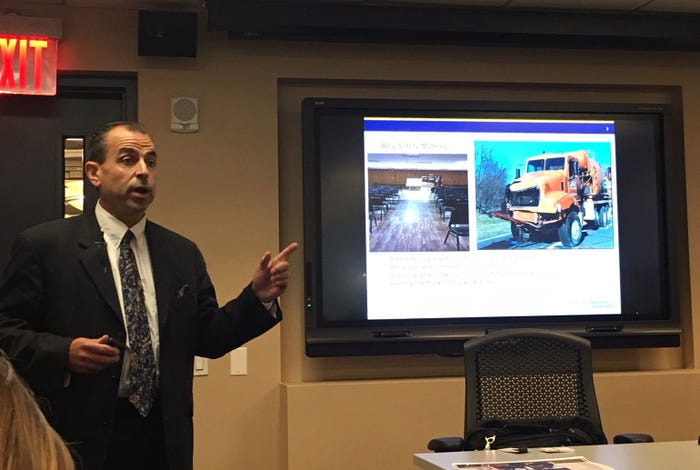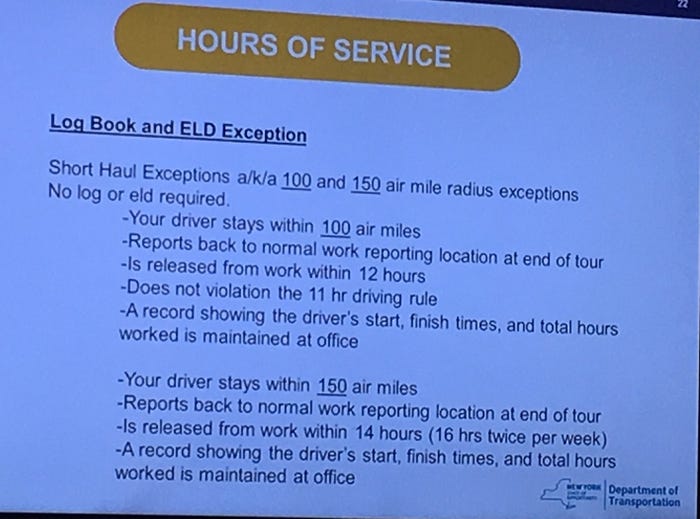NYC Safety Symposium: A DOT Investigator’s Guide to Roadside Inspections
During the safety event for waste and recycling haulers, a state DOT investigator discussed some of the common violations he’s seen during roadside inspections.
When it comes to safety on the roadways, it all starts with the pre-trip. And if waste and recycling haulers want to successfully pass roadside inspections and keep their safety scores intact, pre- and post-trips are key.
Jonathan Nicastro, chief motor carrier investigator at the New York State Department of Transportation (NYS DOT), discussed how to get through roadside inspections during the Fifth NYC Waste & Recycling Safety Symposium. He also touched on some of the common violations he’s seen throughout his 25-year career.
Here are some of the key highlights from the October 18 event, which was sponsored by the New York City Business Integrity Commission, the National Waste & Recycling Association (NWRA), the Solid Waste Association of North America (SWANA) and New Yorkers for Responsible Waste Management.
Pre-trips, Post-trips and Roadside Inspections
Nicastro explained that the crucial element to a solid pre- and post-trip inspection process is thoroughly training drivers and mechanics. For starters, that means they must ensure brakes, steering, lighting, horn, wheels and emergency equipment are all in place and working properly before the truck hits the road.
“All we are doing during the roadside inspection is a pre-trip,” explained Nicastro. “Poor roadside inspections equate to drivers not doing good pre-trip inspections. It could also go back to your maintenance shops. If you do a good pre-trip inspection, I won’t be able to find anything during a roadside inspection.”

He offered a multitiered process that waste and recycling companies could use when conducting pre- and post-trip inspections.
Make sure your drivers are trained.
Check gauges in the truck.
Check engine compartments, seatbelts and emergency equipment.
Check exterior lights and signal lights. Note: Inspectors will place haulers out of service if their trucks’ rear signal lights are out.
Walk around the vehicle and check wheels, tires, lugs, suspension, frame, brakes, brake parts, load securement, etc.
In the cab, test the parking brake, service brake and low air warning.
He added that if a driver is cited for something he or she should have noticed or could have fixed before taking out the truck, companies should refrain from handling citations and summons for irresponsible behavior.
“There should be a sit-down discussion, and it should be made known that this is frowned upon,” Nicastro pointed out. “A driver shouldn’t go out with a flat tire, without lights on or with no seatbelt. But you have to make sure you’ve done your due diligence and trained them on how to do a good pre-trip inspection.”
Nicastro also suggested managers require drivers to fill out a driver vehicle inspection report (DVIR) after every use of each truck. The driver should sign off on it, as should the technician and next driver on duty. He noted that the federal government only requires a DVIR if the driver or equipment has been cited for a defect, but he stressed the importance of it being good practice to do every time.
In addition, he said it is important to make sure driver qualification files are updated and complete, pre-employment screenings can help companies see moving violations for potential drivers, maintenance records and vehicle logs should be kept on hand for each truck and it is a federal requirement for all carriers to have a drug and alcohol program in place.
Common Violations
Some of the most common violations that Nicastro has seen include:
No seatbelt
Not having the proper license, or having suspensions and revocations on license
Lack of driver medical card
Hours of service (HOS) violations and fatigue
Unsafe driving actions
He added that implementing telematics and technology solutions that provide data can help companies monitor driver behavior and overall safety. And driver-facing cameras could also help keep operations safer.
“With driver cameras, drivers will drive safer because they don’t want to deal with you,” Nicastro pointed out. “There are a lot of good features of having video. I laugh at companies when they don’t have video. It’s such an awesome tool to utilize. Having the video in the vehicles can save your drivers. It can help you get rid of nonsense lawsuits and can change the [negative] behaviors of your drivers. Drivers became more cognizant and careful.”
Ultimately, Nicastro emphasized that a crash should always be a learning experience for companies. Post-crash, drivers and hauling companies should be able to address dangerous or improper driving with data and proper training.
Fatigue and Hours of Service
Right now, the state of New York is not enforcing the electronic logging device (ELD) mandate that went into effect nationwide in December 2017. The mandate was passed by the Federal Motor Carrier Administration (FMCSA) in an effort to keep carriers in compliance with driver HOS laws. However, Nicastro pointed out, the state will eventually adopt and enforce the ELD rule or it will lose out on federal funding.
“We are not enforcing the need for ELDs roadside in New York right now,” he explained. “But on a federal level and on other state levels, they are enforcing it. New York is in the adoption phase of the rule now, and it has been delayed because we are being sued by OOIDA [Owner-Operator Independent Drivers Association, which strongly opposes ELDs].”

Though the state has yet to enforce ELDs, drivers who cannot produce a log book that documents their HOS will be put out of service unless they fall under the 100 or 150 air-mile radius exemptions, added Nicastro.
“Your drivers need to be able to explain their hours to us,” he said. “The liability lies with both the company and the driver. You need to have a system in place to catch this stuff. Dispatchers need to be able to catch this.”
Nicastro also pointed out that municipal waste operations—such as government agencies—are not subject to HOS rules, though they are covered under state vehicle and traffic laws.
When it comes to fatigue, Nicastro unveiled statistics that reveal between 2 o.m. and 4 p.m. is the timeframe most fatigue crashes occur. The HOS rules were put in place in an effort to better help carriers manage fatigue among their drivers.

Here are a few more notable statistics on fatigue and overall safety:
Those out driving between 4 a.m. and 6 a.m. have a higher chance of falling asleep behind the wheel.
Pedestrian deaths are on the rise—34 percent of pedestrians get hit while they are intoxicated. About 15 percent of the drivers who hit pedestrians are under the influence.
The most common commercial vehicle violations that impact safety are brakes, load securement, lights and tires.
Moving forward, Nicastro provided some tips that waste and recycling companies could implement immediately if they haven’t already done so:
Institute hiring practices with safety in mind.
Analyze roadside inspection reports—are there loopholes in your operation?
Conduct safety audits (include your maintenance department, check operations and driver departments). Check drivers’ HOS records. Check and update the company’s drug and alcohol testing pool.
Monitor drivers and maintenance technicians with videos.
Join LENS (license event notification system), a DOT program that will allow managers to ensure their drivers are actually properly licensed 24 hours a day. “This gives you the peace of mind that your drivers licenses aren’t suspended, and we catch a lot of drivers with suspended licenses,” explained Nicastro.
Engage and communicate with regulators. “If you’re creative enough, you can get us to come to your office and do a mock roadside inspection with your drivers,” he added. “It’s kind of like pre-trip inspection training with an inspector.”
About the Author
You May Also Like



.png?width=300&auto=webp&quality=80&disable=upscale)
